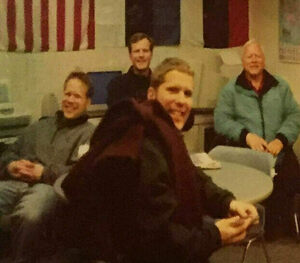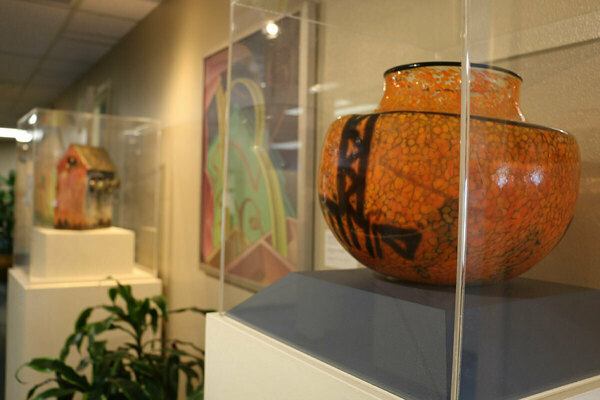

There aren’t many art history majors who end up becoming mayors.
But over the past four years, Tim Keller ’00 has found that leading his hometown of Albuquerque, New Mexico, has much more in common with studying art than he initially thought.
“The ability to understand the pulse of a city is really important in my job, and you have to do that in the same way that you would read a painting,” said Keller, who began his second term as mayor in December. “You have to pull out individual elements that you see, but you also have to understand the context of why it was painted.”
Being able to analyze and understand the context, history, and circumstances of Albuquerque has helped Keller recognize and address his community’s needs. It’s just one of the many surprising ways art history has re-entered his life since earning his degree — and one of the many skills he developed in his liberal arts education that have remained a constant throughout his career.
“Arts and Letters fundamentally comes down to empathy, which you learn academically by studying other people’s works or other time periods,” Keller said. “It translates to interpersonal empathy, or even in my job now, being able to understand a city. It allows me to understand where people are at, and I think that’s critical to being a good mayor or a good public servant.”
“Arts and Letters fundamentally comes down to empathy, which you learn academically by studying other people’s works or other time periods. ... It allows me to understand where people are at, and I think that’s critical to being a good mayor or a good public servant.”
‘A powerful experience’
Keller entered Notre Dame as a biology major, but decided it was not for him after his first year and made a commitment to redesign his college experience around the things he loved.

Reflecting on what had brought him joy in high school — art history, government, and consuming political news — Keller declared a major in art history with a minor in the Hesburgh Program in Public Service at the start of his sophomore year.
While the art history cohort was small and Keller joined a year behind most others, he quickly found his place in a vibrant community of students, many of whom brought other academic interests to the table from their various second majors.
“To me, art history was a good example of how diverse Notre Dame is,” Keller said. “Many people in art history had much different backgrounds than me. I made some great friends and was exposed to so many different life stories in that experience.”
Art history classes became what he looked forward to most every week. He found kindred spirits in his professors and classmates and rediscovered what it was about art history that had drawn him in.
“It’s fundamentally about storytelling,” he said. “And you have to learn the language to be able to read that story from the image or the sculpture or whatever media you’re viewing. And that exercise of learning that language and then drawing out the story from that piece was — and still is — my favorite vocational thing to do. It’s just a powerful experience.”

To broaden his academic horizons, Keller also declared a second major in finance his sophomore year. He became heavily involved in the Student International Business Council (SIBC), serving as president of the club his junior year. Through SIBC, Keller traveled to Honduras, Guatemala, and Russia and developed an interest in international trade that he decided to pursue after graduation.
After Notre Dame, Keller spent two years working in investment banking before moving to Cambodia, a country that was still recovering a horrific genocide two decades prior. Keller worked for Digital Divide Data, the country’s first IT company, which hired landmine victims and formerly trafficked individuals and taught them how to build websites.
“My experience in Cambodia totally changed the trajectory of my life,” Keller said. “At the time, I was discovering what I wanted to do for my professional career, and it made me a real believer in the power of government. It gave me an incredibly global perspective on the role that governments actually play in improving or harming people’s existence. It’s very stark in countries like Cambodia, where the government has so completely failed in all sorts of ways.”
That realization abroad also brought him full circle to some of his studies in the Hesburgh Program, and a commitment to dedicate his life to public service, specifically back in New Mexico — but he also realized he wasn’t ready to move home just yet.
Keller returned to the U.S. to attend Harvard Business School, where art history unexpectedly entered his life again during a summer internship. He landed a research internship position for a private equity firm which was aiming to diversify its financial portfolios while also adding capital to the art market by buying paintings as assets.
His work culminated in co-authoring a Harvard Business School case study, Fernwood Art Investments: Leading in an Imperfect Marketplace.
“I got the job because I had an art history degree,” Keller said. “I do feel like there’s a little divine intervention where art history keeps popping up for me. It was such an amazing experience — I got to spend two months of my life diving back into art.”

‘The power of art’
Still planning to work in government eventually, Keller took a consulting job with Katzenbach Partners in New York City with the hope of developing new skill sets. The firm specialized in culture change and organizational behavior, which he found blended well with his liberal arts background.
After three years learning to effectively manage organizations, Keller told his coworkers that he was moving back to his hometown to get more involved — and that’s what he’s been doing ever since.
He began working for Blue Stone Strategy Group, a Native American-owned economic and governmental development consulting firm, then served six years in the New Mexico State Senate. He served three years as the state’s elected auditor before winning elections for Albuquerque mayor in 2017 and 2021.

Leaving Albuquerque and then returning to it helped him realize the specialness of the city, he said, especially in terms of history and art and the bridge between the two. He credits his art history studies for helping him come to appreciate the contemporary role artists play within the community.
“I view New Mexico as living art history in a way that very few places in America are,” Keller said. “Our artists today are in direct connection, often personally in their own heritage and tradition, to the Hispanic and Native American communities that are here, living in the same place they’ve lived for hundreds or thousands of years.”
While art doesn’t cross over often with the day-to-day tasks of running a city, Keller has found small ways for passion projects to be incorporated into his role. From having the city buses painted turquoise to replacing the country-western art in the mayor’s office with mid-century surrealism and modern landscapes, Keller has paid special attention to art in multiple capacities.
“We punch above our weight for our city size in terms of our very impressive Albuquerque History Museum, and we have a very strong public art and artists support program,” Keller said. “I have invested a lot more of my time and prioritized city resources to help those facilities and champion arts as part of our working economy. We were one of very few cities that prioritized artists as a profession that needed to be supported during the pandemic. All that comes from my belief in the power of art.”
But what Keller draws on most from his Arts & Letters education as mayor are the skills he learned that go beyond subject matter.
Analyzing books and paintings teaches you how to relate to other lived experiences drastically different from your own — which makes a difference in the world, whether you’re working in Cambodia, New York City, or Albuquerque.
“The ability to bring empathy and creativity and innovation together in trying to be a good leader is really important,” he said, “and that’s all truly grounded in liberal arts tradition.”
“The ability to bring empathy and creativity and innovation together in trying to be a good leader is really important, and that’s all truly grounded in liberal arts tradition.”
Originally published by at al.nd.edu on August 17, 2022.